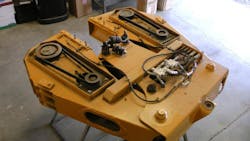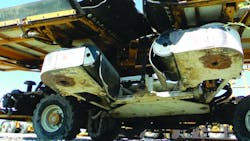This view from underneath the harvester shows the shaker head (white subassembly) and the receiving deck above it.
Nielsen continued, “The operator establishes the shaking process by setting an electronic timer for duration of shake and setting shaking frequency dials to the desired value. The timer setting depends on parameters such as structure of the tree, maturity of the crop, how plentiful the crop is, etc. Typically speaking, though, most shake periods last only 1 to 4 sec.
“Once the operator has lined up the shaker head with the tree, he or she extends the head to position it on the trunk. After the head has been centered, the operator activates clamping cylinders, which grip the trunk of the tree with a force based on a preset clamping pressure. Reaching the preset pressure (1100 psi, in this case) shifts sequencing valves which, automatically initiate the shake pattern. The shaking period terminates when the timer runs out.
“The operator then unclamps the head from the tree and retracts the head back toward the machine chassis. This process is repeated at each tree, typically moving at speeds of four to seven trees per minute.
“A major benefit of our design is the extremely quick, in-field tuning capability. An ideal orchard would be completely uniform. In reality, though, every tree is different within an orchard — and especially orchard to orchard — depending on soil type, irrigation, sunlight penetration, pruning practices, and other factors. As the tree topology changes, the effectiveness of a given shaking input changes. This machine gives us the ability to re-optimize our input to the tree to accomplish the highest crop removal while preventing damage to the tree. It is also extremely helpful to minimize the necessary shake time if desired. In a recent trial we were able to set our shake duration to less than 50% of the baseline.
Hydraulics makes the shakes
The shaking system uses two 75-cc/rev hydraulic pumps, which have electronic displacement control (EDC) that is regulated by electronic amplifiers set by dials in the cab. We use low power potentiometers to communicate EDC pump position to the amplifiers. The amplifiers are voltage-controlled current drivers, so they can provide a constant current as specified by a constant voltage from the potentiometers. Because the EDC pumps use a constant current as a setpoint in their internal closed-loop displacement control system, this helps us stay load and temperature independent.
Each pump drives a hydraulic motor piped in parallel, and each motor drives an eccentric weight through a belt drive. Nielsen revealed, “The reason we use two pumps is because we need to control the speed of each motor independently to produce the most effective shaking pattern. We wanted completely isolated control with closed-circuit operation. A single, larger, open-circuit pump would have required more complex valve circuitry. We tried this — with some success — but it was far more complicated and didn’t have some of the nice features, such as braking with the closed-circuit system.”
The clamping system uses two 41⁄2-in. bore hydraulic cylinders piped in parallel to push the arms of the head together, providing positive contact force at the trunk. The duration of the shake is dictated by an electronic timer, which provides an on-off signal to a hydraulic valve to initiate or terminate the shake. The timers send an on/off signal directly to solenoid valves to initiate the shake. Feedback to the operator is provided by pulse counter displays to monitor the motor speeds from the sensors built into the hydraulic motor cases.”
Endorsement of hydraulics
Nielsen continued, “Hydraulics have become the industry standard for this type of machinery, due to its rugged and reliable nature. Electric motors, on the other hand, have a tendency to become fouled in the dusty, dirty conditions, occasional pressure washing, etc.”
For more information, email Erick Nielsen Enterprises Inc., Orland, Calif., at [email protected] or visit www.eneinc.com.




